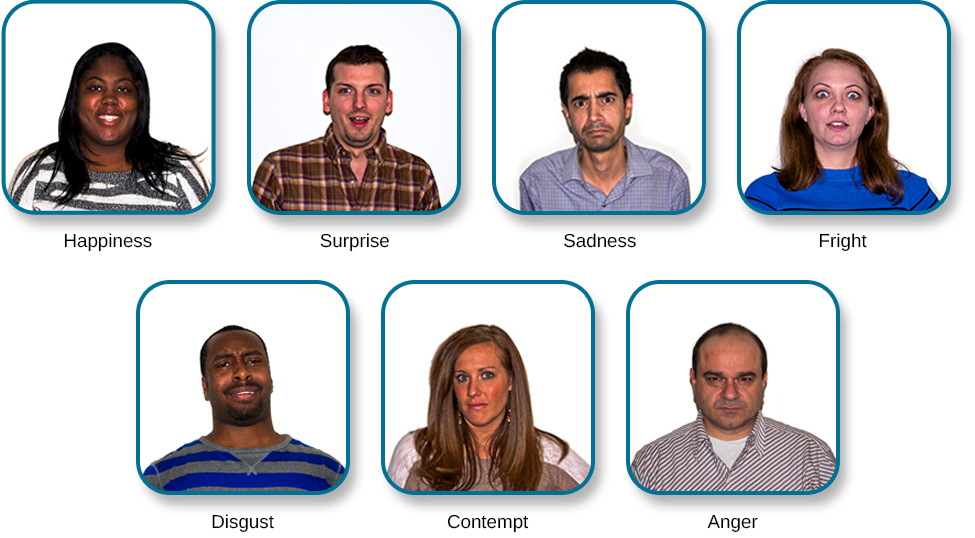| << Chapter < Page | Chapter >> Page > |

Does smiling make you happy? Or does being happy make you smile? The facial feedback hypothesis asserts that facial expressions are capable of influencing our emotions, meaning that smiling can make you feel happier (Buck, 1980; Soussignan, 2001; Strack, Martin,&Stepper, 1988). Recent research explored how Botox, which paralyzes facial muscles and limits facial expression, might affect emotion. Havas, Glenberg, Gutowski, Lucarelli, and Davidson (2010) discovered that depressed individuals reported less depression after paralysis of their frowning muscles with Botox injections.
Of course, emotion is not only displayed through facial expression. We also use the tone of our voices, various behaviors, and body language to communicate information about our emotional states. Body language is the expression of emotion in terms of body position or movement. Research suggests that we are quite sensitive to the emotional information communicated through body language, even if we’re not consciously aware of it (de Gelder, 2006; Tamietto et al., 2009).
Watch this short History Channel video about body language to see how it plays out in the tense situation of a political debate. To apply these same concepts to the more everyday situations most of us face, check out these tips from a Today Show interview with body language expert Janine Driver.
Autism spectrum disorder (ASD) is a set of neurodevelopmental disorders characterized by repetitive behaviors and communication and social problems. Children who have autism spectrum disorders have difficulty recognizing the emotional states of others, and research has shown that this may stem from an inability to distinguish various nonverbal expressions of emotion (i.e., facial expressions) from one another (Hobson, 1986). In addition, there is evidence to suggest that autistic individuals also have difficulty expressing emotion through tone of voice and by producing facial expressions (Macdonald et al., 1989). Difficulties with emotional recognition and expression may contribute to the impaired social interaction and communication that characterize autism; therefore, various therapeutic approaches have been explored to address these difficulties. Various educational curricula, cognitive-behavioral therapies, and pharmacological therapies have shown some promise in helping autistic individuals process emotionally relevant information (Bauminger, 2002; Golan&Baron-Cohen, 2006; Guastella et al., 2010).
Emotions are subjective experiences that consist of physiological arousal and cognitive appraisal. Various theories have been put forward to explain our emotional experiences. The James-Lange theory asserts that emotions arise as a function of physiological arousal. The Cannon-Bard theory maintains that emotional experience occurs simultaneous to and independent of physiological arousal. The Schachter-Singer two-factor theory suggests that physiological arousal receives cognitive labels as a function of the relevant context and that these two factors together result in an emotional experience.
The limbic system is the brain’s emotional circuit, which includes the amygdala and the hippocampus. Both of these structures are implicated in playing a role in normal emotional processing as well as in psychological mood and anxiety disorders. Increased amygdala activity is associated with learning to fear, and it is seen in individuals who are at risk for or suffering from mood disorders. The volume of the hippocampus has been shown to be reduced in individuals suffering from posttraumatic stress disorder.
The ability to produce and recognize facial expressions of emotions seems to be universal regardless of cultural background. However, there are cultural display rules which influence how often and under what circumstances various emotions can be expressed. Tone of voice and body language also serve as a means by which we communicate information about our emotional states.
Think about times in your life when you have been absolutely elated (e.g., perhaps your school’s basketball team just won a closely contested ballgame for the national championship) and very fearful (e.g., you are about to give a speech in your public speaking class to a roomful of 100 strangers). How would you describe how your arousal manifested itself physically? Were there marked differences in physiological arousal associated with each emotional state?

Notification Switch
Would you like to follow the 'Psychology' conversation and receive update notifications?